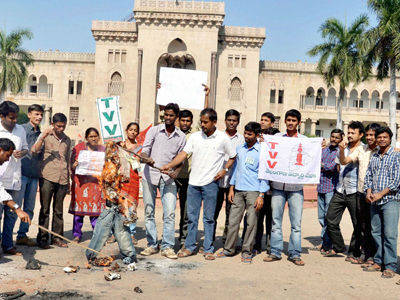Hyderabad :
The year 2013 could well be the last page in the history of ‘united’ Andhra Pradesh as the state stands on the verge of a geographical separation.
If everything goes as per the government’s plan, Andhra Pradesh will get divided into two states – Telangana and (residual) Andhra Pradesh – early this year, bringing to an end the history of a state that remained united for 58 years.

Andhra Pradesh was the first state in the country to be created on a linguistic basis on November 1, 1956 by merging the erstwhile Andhra state and Hyderabad state.
In 1953, Andhra state was carved out of the then Madras Presidency with Kurnool as its capital.
Subsequently, the Telugu-speaking parts of the then Hyderabad state were amalgamated with Andhra state, giving birth to Andhra Pradesh in 1956.
The proposal for amalgamation of Hyderabad state with Andhra state came up in 1953 and the then Chief Minister of Hyderabad state, Burgula Ramakrishna Rao, supported the Congress central leadership’s decision in this regard though there was opposition in the region that was known as Telangana.
Accepting the merger proposal, the Andhra state Assembly passed a resolution on November 25, 1955 promising to safeguard the interests of Telangana.
An agreement was reached between Telangana leaders and Andhra leaders on February 20, 1956 to merge Telangana and Andhra with promises to safeguard Telangana’s interests.
Another agreement was then signed by then chief ministers of the respective states, Bezawada Gopala Reddy and Burgula Ramakrishna Rao, to the effect.
The city of Hyderabad, the then capital of Hyderabad state, was made the capital of Andhra Pradesh.
For 13 years after Andhra Pradesh came into being, everything ran smoothly.
In 1969, however, an agitation began in Telangana region as people protested the “failure” to implement the ‘Gentlemen’s Agreement’ and other safeguards properly.
On January 19, 1969, an all-party accord was reached to ensure proper implementation of Telangana safeguards but that did not satisfy leaders of the region.
Marri Channa Reddy of the Congress launched the Telangana Praja Samiti espousing the cause of a separate state.
Meanwhile, the people’s agitation intensified and turned violent, leading to the death of over 350 people.
In 1972, the Jai Andhra movement started in Andhra- Rayalaseema regions as a counter to the Telangana struggle.
Stalwarts like Kakani Venkata Ratnam, Tenneti Viswanadham and Gouthu Lachchanna led the Jai Andhra struggle in which the likes of M Venkaiah Naidu took an active part.
On September 21, 1973, a political settlement was reached with the Government of India and a Six-Point Formula put in place to placate people of the two regions.
It was agreed upon by the leaders of the two regions to prevent recurrence of any such agitations in future.
To avoid legal problems, the Constitution was amended (32nd amendment) to give legal sanctity to the six-point formula.
Thereafter, peace prevailed across Andhra Pradesh and it progressed on the path of development.
Subsequently, till 1999, there was no demand from any quarters for division of the state on regional lines.
In 1999, the then Leader of Opposition Y S Rajasekhara Reddy of the Congress re-ignited the regional fire making his party MLAs from the region write a letter to the high command demanding creation of a separate state of Telangana.
Yet another chapter opened in the struggle for Telangana when Kalvakuntla Chandrasekhar Rao, who was seething over denial of Cabinet berth in the Chandrababu Naidu government, walked out of the Telugu Desam Party and launched the Telangana Rashtra Samiti on April 27, 2001.
Though KCR launched the Telangana statehood movement in 2001, it remained rather subdued till late 2009 when he tried to sit on an indefinite hunger strike for a separate state.
In October 2008, a rather decisive moment appeared to have come for Telangana when the TDP – one of the main political forces in AP – changed its stance and declared support for bifurcation of the state.
This was a political move that the TDP took to protect its citadel in Telangana as well as dethrone the Congress government.
The TRS was virtually decimated in the 2009 elections and that dealt a severe blow to the statehood movement.
But the sudden and tragic death of the then Chief Minister Y S Rajasekhara Reddy in a helicopter crash in September 2009 gave a re-birth to the TRS and a new thrust to the Telangana struggle.
Following KCR’s agitation that began on November 29, and took a violent turn, the Centre budged and came out with an announcement on December 9, 2009 that it was “initiating” the process for formation of Telangana state”.
But due to a political turmoil caused by en masse resignation of legislators, cutting across party lines, from coastal Andhra-Rayalaseema regions, the Centre went back on its word and came out with another announcement on December 23, 2009 that it was putting the Telangana issue on hold.
Since then, the statehood movement gained momentum in Telangana forcing the ruling Congress to take a final call on July 30, 2013 to create a separate state.
Consequent to the Congress’ decision, the Union Cabinet too approved the proposal to bifurcate Andhra Pradesh and create a separate state of Telangana.
The ongoing protests in Seemaandhra against the bifurcation notwithstanding, the Centre appears determined to go ahead with its exercise and the requisite formalities have been set in motion.
Year 2014 could see the birth of India’s 29th state – Telangana – thereby ending the history of a united Andhra Pradesh.
source: http://www.articles.economictimes.com / The Economic Times / Home> News> Politics and Nation> Andhra Pradesh / PTI / December 31st, 2013